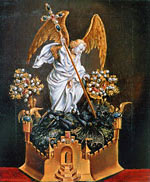items » Image of St Michael
Image of St Michael
From 27 to 30 October 1396, the kings of England and France met at Ardres near Calais to treat for peace amidst splendour and pageantry on a scale comparable to the Field of Cloth of Gold held on the same site in 1520. On the final day, Isabelle of France, not yet seven years old, was brought ceremonially to the English tents as Richard II's future bride. She is said to have wept at leaving her parents and homeland .
Magnificent presents all of gold were exchanged each day at Ardres between the kings (see Charles VI of France). Most received by Richard can be identified in the inventory, although all are now vanished without a trace (see gold vessels). The gifts on 28 October when the twenty-eight year truce was signed were especially sumptuous. Richard II gave Charles VI a gold livery collar which had belonged to Anne of Bohemia. In one English source it was said to be worth the colossal sum of 5,000 marks (£3,333 6s. 8d.). This is close to the total values given in the inventory for all five French gifts presented on the same day, a point of some importance because reciprocal gifts between equals were supposed to match in value.

The lost St Michael from Ingolstadt (Bavaria). Oil painting, eighteenth-century (Munich, Bayerisches Nationalmuseum)
Larger image (41KB)
Charles VI's gifts to Richard on this occasion were a matching pair of large gold flasks, adorned with his Tiger badge (gold vessels) and four gold and jewelled images. Two were warrior saints, Michael and George, both important to Charles VI and more generally in France. The St Michael was the most valuable of the four. An eighteenth-century oil painting in Munich records the appearance of one of several jewelled images of St Michael once owned by Charles VI. It was pawned with other valuables in 1405 to Duke Louis, brother of the French queen, and never returned. Louis gave it to his burial church of Ingolstadt in Bavaria. It disappeared in 1801 during the Napoleonic period. There are some parallels with the image given to Richard. Both stood on a base, both held a jewelled shield and a jewelled cross and wore a jewelled chaplet and were enriched with many pearls.
R 912 Item, un ymage de seint Michel estoisant sur un pee, garnis' entour ove vij balaces, vij saphirs, xiiij troches chescun de iij perlez, un escu ove j grand balace et viij gross' perlez, j crois ove j rubie, iiij perles, et j chapellet ove j rubie, du don' le roy de Fraunce, poisant de Troye vj marcz, et vaut outre, Ml li., dont la somme, Mllxiiij li.
[Item, an image of St Michael standing on a foot, set around with seven balas rubies, seven sapphires, fourteen clusters each of three pearls, a shield with a large balas ruby and eight large pearls, a cross with a ruby, four pearls, and a chaplet with a ruby, the gift of the king of France, Troy weight six marks, additional value £1000, total, £1,064.]
The image of St Michael is listed on membrane 2 of the treasure roll.
